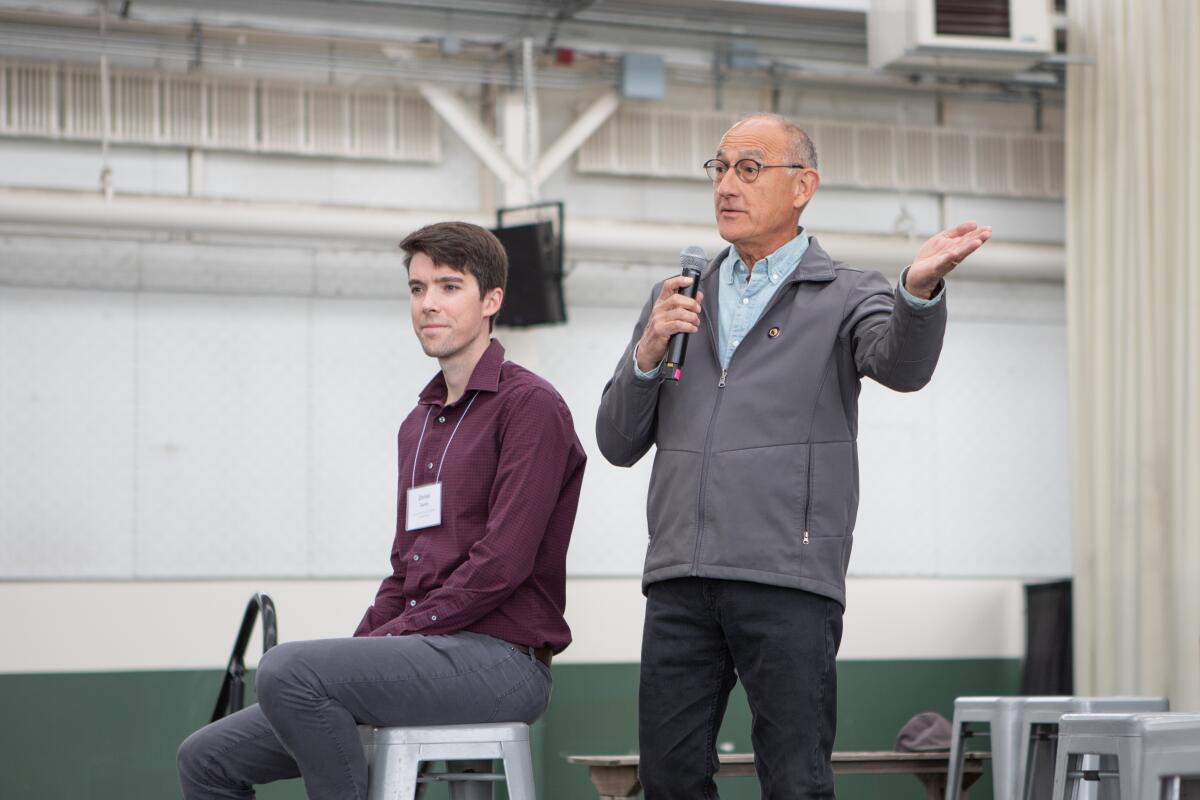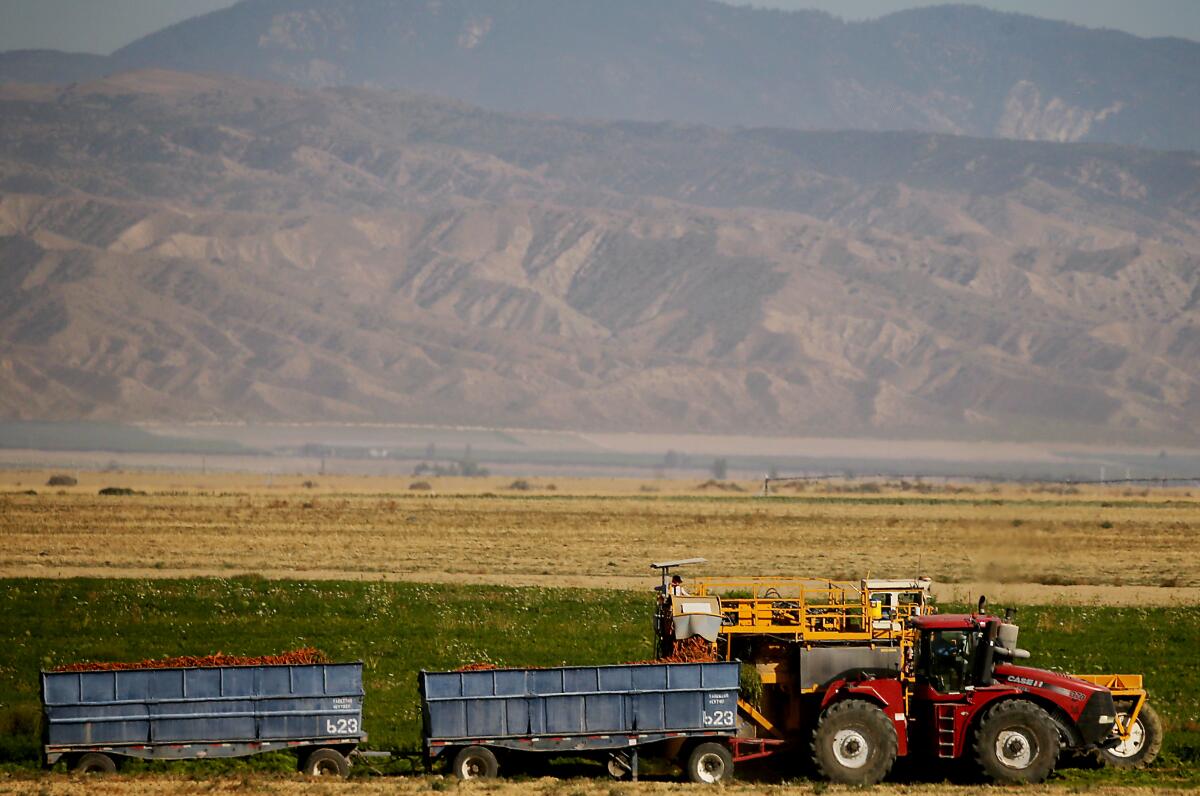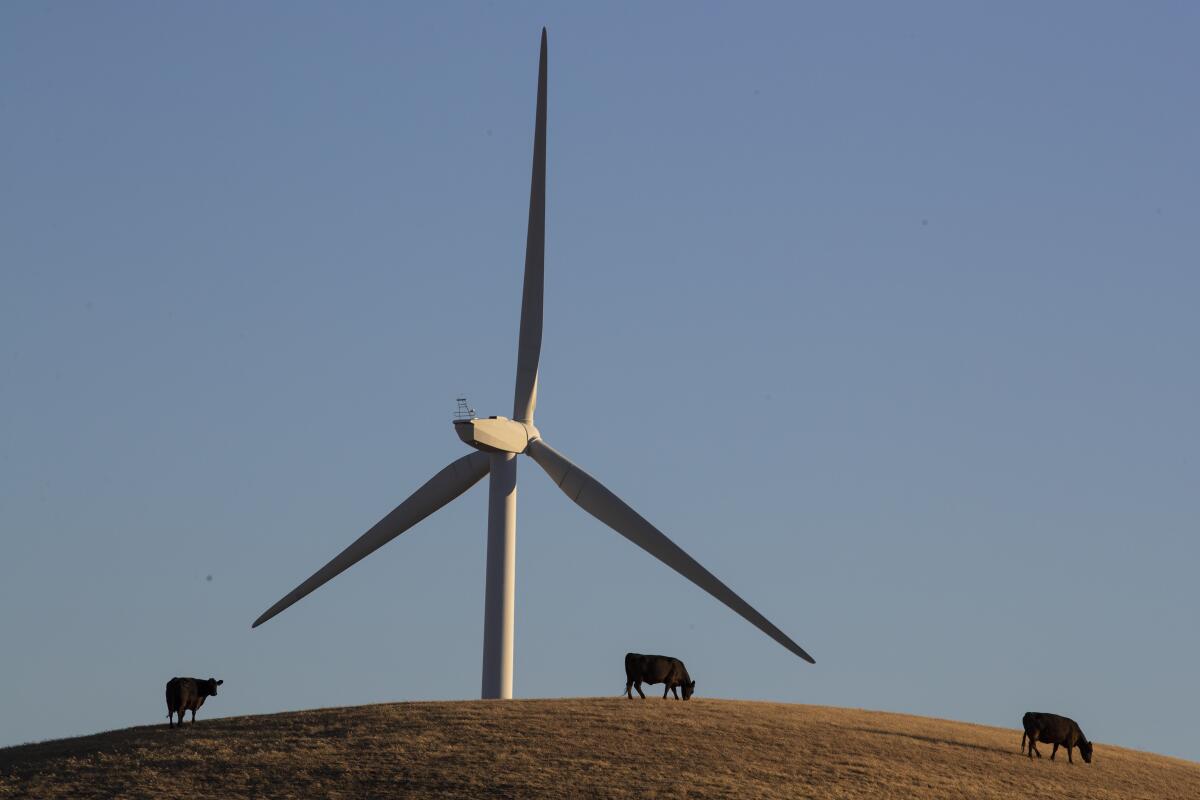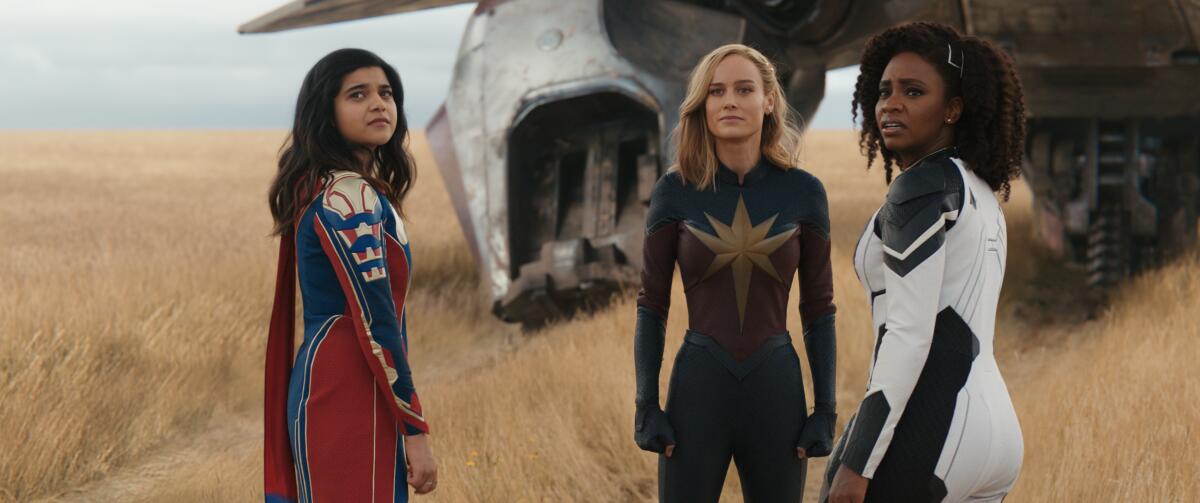Column: Want people to understand climate change? Pay the experts

- Share via
UCLA climate scientist Daniel Swain is tired of working for free.
In a series of posts last week on the social media site formerly known as Twitter, Swain — who has been quoted in The Times and other media outlets hundreds of times over the last decade — lamented how hard it is to make a living sharing information about the climate crisis with the public. He said it’s nearly impossible for climate scientists to get paid for communications work — even though that work is badly needed in an era of rampant carbon pollution.
“The status quo is not sustainable,” Swain wrote.
His posts went viral. They were shared by dozens of scientists and journalists who lamented the lack of public and private funding dedicated to improving public understanding of ever-deadlier heat waves, fires, droughts, storms and more.
You're reading Boiling Point
Sammy Roth gets you up to speed on climate change, energy and the environment. Sign up to get it in your inbox twice a week.
You may occasionally receive promotional content from the Los Angeles Times.
“It’s particularly ironic as scientists are often accused of ‘being in it for the money’ when in fact like teachers who use their salaries to buy supplies for their students, we donate our own salaries and time to these efforts because they matter so much,” wrote Katharine Hayhoe, a professor at Texas Tech University and chief scientist at the Nature Conservancy.
“Journalists rely hugely on a network of scientists who do public-facing communication for free,” wrote Shannon Osaka, a climate reporter at the Washington Post. “But sometimes the significance of that work is not fully appreciated.”
I certainly rely on Swain and other scientists to tell environmental stories — as do my L.A. Times colleagues on our Climate California desk. Those scientists spend time on the phone with us explaining their research, and out in nature showing us firsthand what they’re seeing. They answer our follow-up questions and help make sure we get the details right.
The problem, in Swain’s view, is that scientists typically aren’t compensated for that crucial work — or for anything else they might do to contribute to solving global warming, beyond publishing studies and hoping people take their work seriously.
Among university administrators and federal officials who hold the purse strings for much of America’s science funding — many of whom hail from older generations — there’s a prevailing attitude that “if you’re not doing research, you’re wasting time,” Swain told me. Scientists who want to spend time talking with journalists or advising elected officials — or answering questions through regular “office hours” on YouTube, as Swain has taken to doing — are almost certainly on their own financially.
“If you really want high-quality, sustainable, in-depth public-facing engagement, that has to be the job,” he said. “And that doesn’t exist anywhere.”

When we talked a few days after his social media thread went viral, Swain was eager to explain why it’s incumbent on universities and government agencies — such as the National Science Foundation and NASA — to support not only valuable climate research, but also science communicators who can dedicate themselves to spreading the word about that research.
That kind of full-time communicator role is vital for several reasons, Swain told me.
For one thing, scientists are just like the rest of us: They only have so much time and energy. They’ve got employers who expect a lot from them, not to mention families and friends they care about. If they’re staying up late after putting the kids to bed so they can respond to emails from journalists — or write recommendations for politicians, or record educational videos for the public — “that’s not just suboptimal for work-life balance,” it will also lead to shoddier communications work, Swain said.
Meanwhile, the rise of social media as one of the world’s main sources of information has made science communication more important than ever. Swain cited the aphorism — commonly misattributed to Mark Twain — that “a lie can travel halfway around the world while the truth is still putting on its shoes.” That’s true now more than ever.
“Society has changed, and we haven’t scaled up the ability of experts to deal with that new information landscape,” Swain said.
Even with better communication, I don’t think we’ve got much hope of convincing climate deniers that global warming is real.
But there’s other dangerous disinformation being spread by fossil fuel interests and right-wing media all the time — claims that wind turbines were to blame for the terrible blackouts in Texas a few winters ago, for instance. (They were not.) There’s also lots of new climate science worth exploring — and more nuanced information about how carbon pollution from coal, oil and natural gas is influencing our daily lives, from working conditions to baseball games to the beaches we love.
Swain has focused on the many connections between weather and climate change, contributing in recent years to studies on atmospheric rivers, megafloods, fire risk and more. With California ricocheting between ever-more-devastating droughts and storms — and more prone than ever to destructive conflagrations — his expertise has been increasingly in demand.
But with the outside funding that supports much of his UCLA salary drying up next year, Swain has been “spending much effort scrambling to find some way to support my climate scientist-communicator role,” as he wrote on social media. He told me he’s talked with philanthropic groups and wealthy individuals who have made climate a focus, and has found them to be “incredulous” that no one else is already funding this kind of communications work.
So far, none of them have offered to help pay his salary.
“There’s just been this bizarre gap,” he said.
Swain emphasized that he’s grateful to his bosses at UCLA, who have supported and encouraged his science communications work (which he estimates takes up more than half of his time). He’s hopeful he’ll find a way to keep it going financially.
He also sees the dearth of science communications funding as a problem in other fields, not just climate. Epidemiologists who specialize in public health, geopolitical experts who can offer context on global conflicts — when they go on CNN or talk with newspaper reporters or share information on social media, they’re doing it in their spare time, without being compensated.
That needs to change — at least if we want to improve the odds of creating a safe, habitable planet.
One more thing that would help? If more people subscribed to their local news organizations — especially those of us taking the climate crisis seriously. I realize that sounds self-serving. But aggressive climate journalism is crucial to breaking the stranglehold of fossil fuels.
You can support me and my colleagues covering climate for the Los Angeles Times by paying for a digital subscription.
Alrighty, let’s get to the news. Here’s what’s happening around the West:
TOP STORIES

An incredible new analysis concludes that 20 farming families in California’s Imperial Valley use 1.2 million acre-feet of Colorado River water — one-seventh of the entire flow in the river’s Lower Basin. There’s one extended family in particular that uses more than the entire Las Vegas metro area, per this breathtaking reporting by ProPublica’s Nat Lash and the Desert Sun’s Janet Wilson. How did Imperial end up using so much Colorado River water? Here’s a fascinating history lesson from Wilson and Lash. And if you want to learn more about this desert farming region, see my 2018 investigation into powerful grower Mike Abatti — a member of the farming family that uses more water than Vegas.
America’s first commercial plant to pull carbon dioxide directly from the air has begun operations in California’s Central Valley. The New York Times’ Brad Plumer wrote about why we need carbon capture projects like this one — and what they leave to be desired. The Central Valley plant opened just after Earth’s fifth straight month of record-breaking heat, during a year that’s on track to be the hottest on record — 1.43 degrees Celsius warmer than the preindustrial average so far, as my colleague Hayley Smith reports. That’s dangerously close to the 1.5 degrees scientists have urged us to avoid. And lest you think carbon capture will solve all our problems, a new United Nations report find the world’s biggest economies — including the U.S. — are planning big increases in fossil fuel production out of line with a safe climate. Details here from Inside Climate News’ Nicholas Kusnetz.
Has California learned from the fire that destroyed Paradise and killed 85 people five years ago this month? Some towns in forested areas are better prepared for flames — but many others aren’t, The Times’ Hayley Smith and Alex Wigglesworth report, in a powerful reminder of our slow pace of change even amid planetary crisis. In more encouraging news, a new study finds that beneficial fires — whether “prescribed” burns ignited on purpose or naturally sparked low-intensity fires — can slash the risk of destructive, high-intensity blazes by 64% for at least six years, KQED’s Danielle Venton reports.
WATER IN THE WEST

There’s a carrot war in the Southern California’s Cuyama Valley. Santa Barbara County residents are boycotting two of the world’s largest carrot-growing companies — a response to Grimmway Farms and Boathouse Farms suing other local property owners to try to secure their groundwater pumping rights, The Times’ Ian James reports. Ian also shared personal stories from another half-dozen locals boycotting the companies. In other groundwater news, my colleague Louis Sahagún explained why a California desert city wants to cut down on groundwater pumping by building a 50-mile pipeline to bring water from northern rivers. It’s a controversial plan, criticized not only by environmental activists but also by local farmers and miners.
Gov. Gavin Newsom is moving to fast-track the proposed Sites reservoir, under the terms of a new law designed to speed up water, energy and transportation projects. Here’s the story from Kurtis Alexander at the San Francisco Chronicle, who notes that Sites — which is planned for an off-river location 70 miles north of Sacramento — would be California’s first new big reservoir in nearly 50 years. And although there are environmental downsides, L.A. Times political columnist George Skelton isn’t moved by them, writing, “OK, too bad! We need water for drinking, bathing and growing food. It’s a necessary tradeoff.”
There’s a nifty Colorado River water deal in the works involving San Diego, the Imperial Irrigation District and the Los Angeles-based Metropolitan Water District of Southern California. The deal would result in the federal government paying Imperial Valley farmers to cut back on irrigation and more water being left in Lake Mead, per MacKenzie Elmer at Voice of San Diego. In other Colorado River News, two San Diego County communities voted last week to ditch the county’s water authority, persuaded they can get cheaper water elsewhere after the county ponied up to buy large amounts of water from the Colorado River, a seawater desalination plant and local recycling facilities.
THE ENERGY TRANSITION
Oil giant Chevron has spent almost twice as much money lobbying the California Legislature as any other company or group this year — and the Western States Petroleum Assn., an oil industry trade group, is second. Check out the numbers here, courtesy of CalMatters’ Jeremia Kimelman. Fossil fuel dollars continue to play a big role nationally too, with the Washington Post’s Josh Dawsey and Maxine Joselow reporting that oil and gas company executives are starting to line up behind Trump in the Republican presidential primary campaign — especially as he goes on the attack against clean energy, a topic I wrote about last week. Although some wealthy Americans have made climate philanthropy a priority, a new report finds that people and foundations are directing less than 2% of their philanthropic donations to climate causes, Heated’s Arielle Samuelson reports.
Pacific Gas & Electric took another step toward keeping the Diablo Canyon nuclear plant operating past its 2025 shutdown date, submitting a license renewal application to the federal government. The San Luis Obispo Tribune’s Mackenzie Shuman has the details, writing that PG&E asked the Federal Energy Regulatory Commission for a 20-year license extension — far longer than the five years sought by California Gov. Gavin Newsom. In less-positive news for nuclear power supporters, the Deseret News’ Amy Joi O’Donoghue reports that a group of Utah utilities canceled a deal with nuclear startup NuScale amid rising costs.
California has its first 100% renewable power system that can operate totally on its own, separate from the main electric grid. The climate-friendly microgrid was installed by PG&E at a Sonoma County wildlife preserve and includes a solar carport and battery storage system, Mary Callahan reports for the Santa Rosa Press Democrat. As much potential as clean energy advocates see for microgrids, the California Public Utilities Commission seems to be pretty averse to them — except for the kind owned by big utility companies, at least according to this story by Latitude Media’s Maeve Allsup.
POLITICAL CLIMATE

The wind energy industry is supporting a bill pushed by the U.S. Air Force that would create two-mile buffer zones around nuclear missile silos in which new wind turbines aren’t allowed. For more information, see this story by the Associated Press’ Tara Copp. Elsewhere on the clean energy landscape, the Biden administration temporarily halted construction of a major power line that will bring wind power from New Mexico to California, in the face of concerns raised by the leader of the Tohono O’odham Nation about harm to ancient burial sites and other sacred areas. The Arizona Daily Star’s Tony Davis has the story.
Michigan’s new climate law will require 100% clean energy by 2040 — five years ahead of California’s deadline. Canary Media’s Jeff St. John has the details; I mostly care about the fact that Gov. Gavin Newsom hasn’t made it a priority to move up the Golden State’s 2045 target, even though it’s been three years since he called our timeline “inadequate.” In Colorado, meanwhile, officials say the state isn’t on track to meet its goal of cutting planet-warming pollution 50% by 2030 and needs to prioritize denser urban development and broader access to fare-free public transit, the Colorado Sun’s Michael Booth reports. And in Maine, voters rejected a proposed public takeover of two for-profit electric utilities by a 2-to-1 margin, Canary Media’s Julian Spector reports.
Environmental groups cut programs as funding shifts to climate change. That’s the headline of this New York Times piece by Ralph Vartabedian, who writes that prominent groups including the Natural Resources Defense Council and the Sierra Club have seen “a significant shift in donor contributions” as wealthy patrons direct more of their dollars toward climate — a shift that has left those groups “facing critical shortfalls in programs on toxic chemicals, radioactive contamination and wildlife protection.” On the one hand, it’s super unfortunate to see environmental groups laying off staff in those crucial areas. On the other hand, I’m inherently skeptical of narratives that seem to suggest we’re devoting too much time or money to climate change. It’s the No. 1 environmental threat we face, and it should absolutely be the top priority for most of these groups.
AROUND THE WEST
California is 100% drought-free — for now. My colleague Terry Castleman put together some maps showing how remarkable the state’s transformation has been over the last year — and reminding us that dangerously dry conditions will almost certainly return before too long, especially given the climate crisis. For now, all the water coursing through Western rivers is serving as a reminder of how much we rely on hydropower. In Nevada, for instance, rural farmers worry that a push to tear down four dams along the Snake River in Washington state could deprive them of a source of cheap electricity, the Nevada Independent’s Daniel Rothberg reports.
The discovery of rare-earth elements at a Wyoming coal mine could be a game-changer for America’s energy transition. The Wall Street Journal’s Julie Steinberg has a fascinating look at the site, which currently contributes to fossil fuel pollution but could eventually help supply parts for electric cars and offshore wind turbines. On the flip side, the fewer rare-earth minerals that we need to extract from the Earth, the better. A “right to repair” law signed by Gov. Gavin Newsom last month could help on that front, by limiting electronic waste and creating a new source of recycled rare earths, The Times’ Susanne Rust writes.
“The hurricane’s intensification was among the fastest forecasters have ever seen: Its top-end windspeed increased by 115 mph in 24 hours.” That’s how CNN’s Rachel Ramirez described Hurricane Otis, which slammed into Mexico late last month. My colleague Patrick J. McDonnell offered an up-close look at the damage in Acapulco, writing that the storm “ripped through the fabled Pacific resort and wrought unprecedented devastation, leaving at least 48 dead and 31 still listed as missing, and exacting up to $15 billion in damage.” This is what climate change looks like: bigger, deadlier, more destructive storms.
ONE MORE THING

If you’ve been reading this column for a while, you may have picked up on how obsessed I am with the idea of TV shows and movies doing more to highlight the dangers of global warming — and the clean energy solutions at our fingertips.
So I was tickled this weekend to see one of the main characters in “The Marvels” — the latest entry in Disney’s Marvel Cinematic Universe — explain a bit of sci-fi magic with an analogy about how the oil and gas drilling method known as fracking can trigger earthquakes. Indeed it can. When fossil fuel companies inject fracking wastewater underground, they can induce quakes.
The line in “The Marvels” felt totally out of place, truth be told. But I’m not complaining.
If you worked on the film and know how that line made it into the script, please do drop me a note!
This column is the latest edition of Boiling Point, an email newsletter about climate change and the environment in California and the American West. You can sign up for Boiling Point here. And for more climate and environment news, follow @Sammy_Roth on X.
Toward a more sustainable California
Get Boiling Point, our newsletter exploring climate change, energy and the environment, and become part of the conversation — and the solution.
You may occasionally receive promotional content from the Los Angeles Times.






